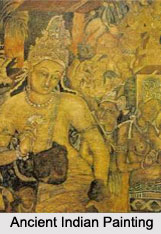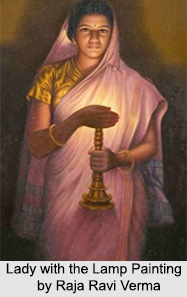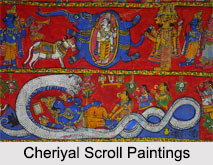 A domestic ritual art for the women of rural Bengal, alpana is a folk art which is intrinsically linked with the folk rites known as "brotos". These rituals are undertaken with a view to achieve the fulfilment of specific desires. These rituals serve as a spontaneous expression of attitude, cultural heritage and traditions of the women of Bengal. The brotos or vows are undertaken by women of all ages to seek peace and happiness for their family and kinsman.
A domestic ritual art for the women of rural Bengal, alpana is a folk art which is intrinsically linked with the folk rites known as "brotos". These rituals are undertaken with a view to achieve the fulfilment of specific desires. These rituals serve as a spontaneous expression of attitude, cultural heritage and traditions of the women of Bengal. The brotos or vows are undertaken by women of all ages to seek peace and happiness for their family and kinsman.
In his book called Banglar Broto or the Religious Rites of Bengal, Abanindranath Tagore, the maestro of folk art, was the first to draw attention to the importance of alpana and its link with the many religious rites prevailing in Bengal.
Etymology of Alpana
It is believed that the word alpana has its roots in the Sanskrit language and is derived from the word "Alimpan", which means to plaster or to coat with. In rural Bengal, painting alpana is a traditional form of folk art which has been going on for generations.
Materials used for Alpana
This sacred art of designing alpana is done with hands and paint, which is mainly a paste of rice and flour. By dipping a rag in the paste the women could design colourful motifs and patterns on the floor and even on the walls and door posts. The alpana is strictly supposed to be in white but with changing times fabric colours are now used and there are also green and red alpanas. It is said when done organically, the green colour is done by using green leaves and the red colour is achieved by using vermilion powder.
 Techniques for Alpana
Techniques for Alpana
Using the paste of rice and flour, the artist dips the cloth and then begins her work from the centre and works outwards. Each stroke is applied using the ring finger, while the quantity of paste dripping from the rag is controlled by applying appropriate pressure of the thumb.
It is known that each alpana has a set of ritual forms, which depicts a ritualistic expression of the rural Bengali woman"s hopes and aspirations. It was believed that in shaping their goals and aspirations into an idol fulfils them. Other than floors and walls, alpanas were also painted on earthen pots, winnowing trays, low wooden stools, also known as piris and paddy bins for auspicious occasions.
Themes of Alpana
With a variety of themes, the designs of the alpana are conscious of the changing moods of the seasons and thus the artist"s creativity marks the changing cycle of the year. Circular alpana is used as a holy pedestal during festivals such as the Saraswati Puja and Diwali. Other designs drawn with the technique include the sun, swastika, a rice stem, an owl, a ladder, a plough, the footprints of the Goddess Lakshmi, a fish, betel, a lotus shankhalata and also abstract designs to give it a unique touch.
Alpana is known to be a unique folk art of Bengal which gives voice to the artistic expression and creativity of the womenfolk of the state.



















